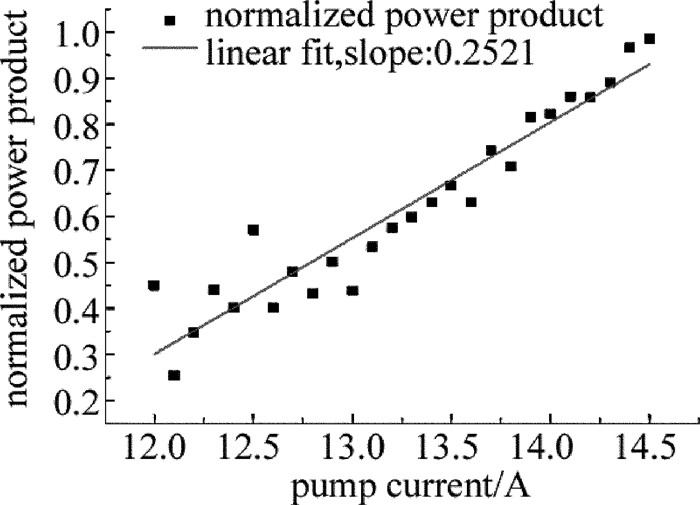HTML
-
现如今,日益增长的数据流量使得整个社会对频谱资源及带宽有了越来越高的要求。同时具有微波、远红外波优点的毫米波(1mm~10mm)由于其频段高、波束宽、损耗小、方向性好、抗干扰性强等优点在各应用领域都展现出了巨大的应用前景[1-5]。相比于两个独立振荡的单频激光器组成双频光源,使用输出频差稳定的双频微片激光器,外差拍频可以产生更高纯度的毫米波信号[6-7]。在众多激光器增益介质材料中,掺钕(Nd)离子的材料,比如Nd:YAG陶瓷/晶体和Nd:YVO4晶体由于其非常优秀的光学性能(高增益系数和宽吸收带宽),是理想的微片激光器增益介质材料[8-11]。GOUËT等人[12]报道的双频单轴Nd:YAG激光器,利用加载电压的锆钛酸铅镧陶瓷(lead lanthanum zirconate titanate, PLZT)实现模式分裂,通过调整PLZT标准具所受的电压实现频差的可调谐,最终实现频差在11GHz~127GHz内可调谐的双频信号输出。白俄罗斯国家科学院的GUDELEV等[13]研究人员报道的基于耦合腔结构的双频Nd:YAG激光器,通过耦合腔和力控Nd:YAG晶体引起的双折射效应分别实现模式选择和模式分裂,最终实现频差在50MHz~8.4GHz内可调谐的双频信号输出。
考虑到双频激光器的输出光信号投射到传感器上并外差产生射频信号时,输出射频信号的振幅与双频光信号振幅呈乘积关系[14]。因此当无法提高输出光总功率的前提下,使双频光信号的输出光功率达到功率均衡也可以获得更高的外差转换效率[15]。本文中对基于Nd:YVO4单块晶体的双频激光器进行实验研究,通过改变晶体热沉的温度对不通抽运电流下双频激光信号的功率均衡度进行调节,最后获得功率均衡的双频激光信号。
-
多波长激光器的波长数理论模型如下所示[16]:
式中,M为晶体增益内波长数的最大值;Δν0为晶体的增益频宽;c为真空中光的传播速度;n为晶体的折射率;L为激光腔体的几何长度。
图 1为双频激光器模谱示意图。横坐标表示频率ν,纵坐标表示激光晶体增益g(ν)。通过设计激光墙体的几何长度,可以将模式间隔Δν=c/(2nL)控制在(0.5~1)Δν0之间,即可获得双频激光信号输出[17]。
均匀加宽增益介质的固体激光器的发射谱符合洛伦茨线型分布[18]。由于拍频效率受双频激光信号的功率均衡度的直接影响,而双频波长在增益介质发射谱内对应的发射截面不同是造成功率均衡度差异的主要因素。当双频激光信号的双频波长在发射谱峰值两侧对称位置时,其对应的发射截面值是相同的,进而其输出的双频信号是均衡的。
Nd:YVO4晶体的温度变化会对其折射率和腔体几何长度产生影响[19]。由于双频激光器的波长与腔体的光学长度相关,因此温度变化将导致双频波长变化。在实验中,可调节激光晶体温度,从而实现激光晶体发射谱与双频微片激光器谐振波长的相对移动,并且最终获得功率均衡的双频激光信号输出。
-
图 2所示是实验装置。尾纤输出的激光二极管(laser diode, LD)是抽运源,输出的光纤芯径为400μm,波长是808nm。抽运光通过光纤之后,采用焦距为100mm的非球面凸透镜,聚焦到Nd:YVO4晶体中。透镜和增益介质的中心位于同一光轴上,功率光纤和透镜的距离是固定的。利用光谱分析仪(optical spectrum analyzer, OSA)对双频激光的光谱特性进行测量,分辨率为0.02nm。
在实验中,采用一个a-cut的Nd:YVO4晶体作为双频微片激光器的增益介质。Nd:YVO4晶体的两个端面上各镀上了两层介质膜,分别为输入耦合镜和输出耦合镜,这两层膜和Nd:YVO4晶体共同形成了一个腔长为1mm的激光谐振腔。其中,Nd:YVO4晶体纵向尺寸为1mm,Nd3+离子的原子数分数为0.010,折射率为2.165,输入耦合镜的膜系参量为1064nm高反射膜(HR@1064nm)和808nm增透膜(AR@808nm),输出耦合镜的膜系参量为1064nm反射膜(反射系数R=0.9@1064nm)。为了对双频微片激光器进行良好的温控,实验中选用了热沉铝块夹持微片晶体,同时在Nd:YVO4晶体的外部包覆了一层0.1mm厚的铟箔,热沉通过半导体制冷器(thermoelectric cooler, TEC)进行温度控制,温控精度为0.1℃,温控范围为0℃~100℃。
在实验过程中,调节抽运电流使之从12.0A以0.1A的间隔变化到14.5A,每次改变抽运电流之后都通过改变晶体温度并经过一段时间使双频激光达到均衡状态,记录下不同抽运电流下达到功率均衡时的激光光谱图、温度和双频功率。分析功率均衡温度、双频功率和抽运电流之间的关系。
当抽运电流从12.0A变化到14.5A时,获得了一系列功率均衡的双频光谱。图 3是电流从12.0A以0.1A的间隔变化到14.5A时得到的归一化激光光谱图。以14.5A时的短波激光光谱的最大值作归一化。由图 3可见,随着抽运电流的增加,双频激光光谱大致保持不变,信号强度逐步增加。图 4是图 3中的具体参量。图 4a图是双频功率均衡温度与抽运电流的关系,图 4b是双频激光波长与抽运电流的关系。
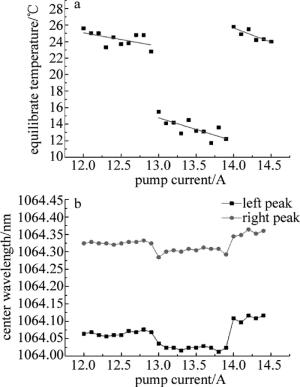
Figure 4. a—relationship between equalization temperature of dual band laser power and pump current b—relationship between wavelength of dual frequency laser and pumping current
当抽运电流从12.0A增加到14.5A的过程中,均衡温度在电流为12.9A与13.9A之后发生了两次明显的跳变,分别从22.8℃, 12.2℃跳变至15.5℃, 25.8℃;在每一个分段的小区间内,直线是线性拟合的结果,校正决定系数分别为0.224, 0.519及0.701,斜率分别为-3.11℃/A, -3.67℃/A及-3.61℃/A,即可认为功率均衡温度与抽运电流均呈负相关,如图 4a所示,这是由于当抽运电流增大时,晶体温度升高,故需要降低激光晶体温度以重新实现功率均衡。双频激光波长与抽运电流的关系如图 4b所示,从图中可知,波长也发生了与温度相同趋势的跳变。其中,当电流从12.9A变化到13.0A的时候,长波波长从1064.068nm蓝移至1064.036nm,短波波长从1064.324nm蓝移至1064.284nm;当抽运电流由13.9A加至14.0A时,长波波长从1064.292nm红移到1064.344nm,短波波长从1064.024nm红移到了1064.108nm,这是由于跳模引起的。
图 5是归一化功率乘积与抽运电流的关系图。取不同抽运电流下双频功率的归一化结果做积。当抽运电流由12.0A以0.1A的间隔变化到14.5A时,归一化功率积从0.449变化到了0.986,其中最大值0.986,最小值0.255。图中直线是线性拟合的结果,校正决定系数为0.904,拟合直线的斜率为0.252,可认为归一化功率积随抽运电流的增大而增大,并且呈线性关系。尽管大体呈线性关系,但是仍然可以看到,当电流较小时,归一化功率积偏离拟合直线的现象较为严重,这主要是实验所采用温控精度为0.1℃,没有办法实现完美功率均衡造成的,因此在功率较低的条件下,拟合偏离更加严重。在下一阶段采用精度为0.01℃的温控,即可获得更好的拟合效果。
-
在功率均衡的双频微片激光器中,当抽运电流增大时,需要降低激光晶体温度重新实现功率均衡,功率均衡温度与抽运电流呈分段负相关关系;此外当抽运电流增大时,在重新实现功率均衡之后,归一化功率积随抽运电流的增大而增大,因此,通过改变抽运电流和温控温度可以实现功率可调的功率均衡的双频激光信号输出。

 Map
Map


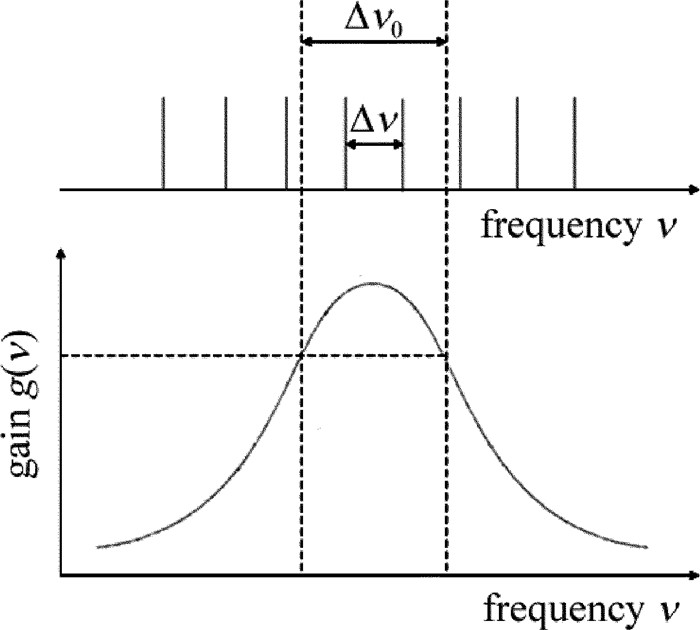

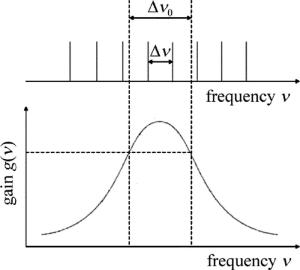


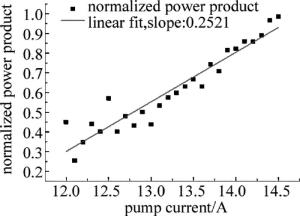
 DownLoad:
DownLoad:



